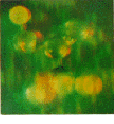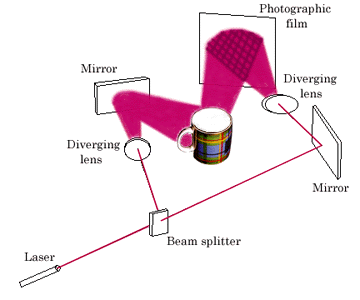Light & Optics Supplementary Module: Holograms
Steve Beeson, Arizona State University

You've probably got a hologram in your pocket or purse right now. Just look at a
credit card. One of my cards has a dove hologram on it, another has a map of the world.
Why do our credit cards have holograms on them?
Mainly it's for the bank's protection, in case someone tries to duplicate the card. Since it's very hard to replicate a hologram, there's less of a chance for forgery. But why is it so hard to duplicate a hologram? How does one make a hologram, anyway?
A hologram is essentially a three-dimesional photograph. However, it takes
much more work to make a hologram than it does for an ordinary two-dimensional
photograph. To learn how holograms are made, we first need to learn a little
about lasers.
Interference is what holograms are all about. A hologram is basically a reproduction of the "interference pattern" of laser light that's been shined on something. Let's say we had a coffee cup and we shone some laser light on it. However, we didn't shine all of the light on the cup. Some we diverted directly onto the photographic paper (the reference beam). The rest of the laser light (the object beam) shines on the cup, and is then reflected onto the paper. So we have light straight from the laser source and light that's been reflected from the cup. These two beams interfere with each other, causing a specific pattern of bright and dark spots where there has been constructive and destructive interference, spots where the waves added and subtracted.

It's the interference pattern that the photographic film records, unlike a regular photograph, which records the amount of light from a specific point (see the module on pinhole cameras for more information). Also, unlike the photograph, each point of the hologram contains all of the information from the object. So we could destroy almost all of our hologram and still reconstruct the image from a small piece. Try to do that with your regular photograph!
To see the hologram, we have to shine light that's just like the reference beam onto the photographic film after it's been developed. To see the hologram made from a laser, we need to use a similar laser. Now do you see why it's so hard to duplicate a hologram?!
What about the holograms that I can see everyday on my credit card without a laser?
 Modules
Modules
 Light & Optics
Light & Optics
 Supplementary
Supplementary
 Readings
Readings
 PiN Homepage
PiN Homepage
 ACEPT
ACEPT
 Glossary
Glossary
 Help
Help